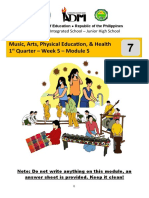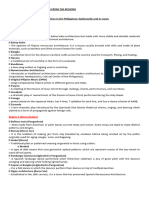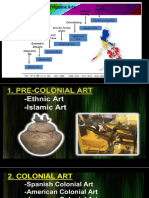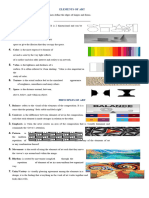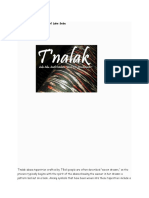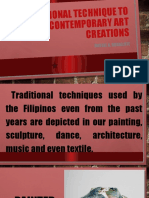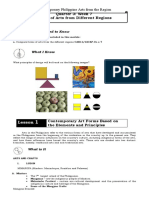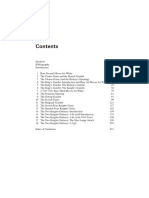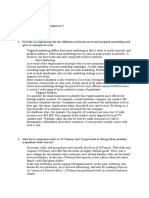IV.
Discussion
Below are the seven (7) major Contemporary Art Forms in the Philippines and practices from various regions.
1.
Visual Arts
.
The Philippines is home to a long and rich history of excellence in visual arts. This tradition started as early as the 19th century. Aside from painting and sculpture, here are the other art forms that can be seen in every region in the country where some of them are even used by people on a regular basis.
A.
Bamboo Art.
Works made in bamboo that may be used for everyday purposes or for decorations or ornaments. Thick Bamboo is typically used for building sturdy structures, decorations, and furniture while thin bamboo is used in creating musical instruments and personal accessories. B.
Basketry.
Basketry is an ethnic tradition of weaving and one of the functional art of many nations. The intricate patterns on the weaves are repeatedly done creating harmony and rhythm. Grasses and twigs are woven to make baskets. C.
Embroidery.
Art of Stitching ornaments on cloth by hand. In the town of Lumban in Laguna, embroidery has flourished as a major industry.
D. Food Art.
This involves packaging/ or presentation of food in artistic way. Sapin-Sapin is a good example of this. It is a filipino steamed dessert that is made of glutinous rice flour, coconut milk, sugar, and flavoring. D.
Leaf Art.
It is used in religious rituals, food wrapping and even as a form of modern artistic expression. The
palaspas
that is used every Palm Sunday is an example of leaf Art.
Tumpong of Maranao Ata Talaingod Liyang Basket Weaving Lumban Embroidery Sapin-sapin Palaspas
E.
Paper Art.
This involves the processes of cutting, pasting, recycling, and/or constructing of objects from paper. Paper art used to be limited with folks paper art such as taka and higante from angano, parol, pastillas wrappings and kites. F.
Textile Weaving.
This refers to the process of creating cloth by interweaving a series of parallel vertical threads at right angles. Textile may be plain or decorated by dyes, embroidery, and applique. Some examples are abel iloko from
Ilocos, T’nalak from Cotabato and Yak
an tribe tapestry from Basilan. Other visual arts of the Philippines include the Tattoo Art, Pottery, Photography, Printmaking, Personal Ornaments, Multimedia, Mat Weaving, Metal Craft, Book Design and Costumes. All of these reflect our own practices and culture.
2.
Architecture.
Thin e history and the culture of the Philippines are reflected in its architectural heritage, in the dwellings of its various peoples, in churches and in the buildings that have risen in response to the demands of progress and the aspirations of the people. Below are some of the Philippine architectures which express traditions and values of the our country.
A.
Bahay na Bato.
During the 19
th
and 20
th
century, this is considered to be the residence of the wealthy. It is a typical two-story house that has a ground floor made of brick or stone and has a wooden upper level. The Rizal Shrine is a reproduction of the original two-story house, Spanish-Colonial style house in Calamba, Laguna.
B.
Bahay Kubo.
It is an ethnic house of Christian Peasant families living in the lowland areas. It has pile construction and a roof sliding in all sides. A typical materials in building bahay kubo uses bamboo and coco lumber for the beams and joist, nipa shingles for the roof and windows, bamboo slats for flooring, railings and even for benches
Parol Yakan Tribe Tapestry
Rizal Shrine Bahay Kubo
and stair steps. As for walls, sawali can be used framed with bamboo slats. C.
Houseboat.
It is basically a boat that also serves as a dwelling. The Badjaos and Sama Laut typically reside in houseboats. D.
Churches Structure.
Place of worship for a Christian congregation. How a church was designed usually depends on a religious denomination. Paoay Church, also known as San Agustin Church, is one of the top tourist destinations in the province of Ilocos. It was founded by Augustinian missionaries in 1593, and was a labor of love over time and in the face of earthquakes and other disasters.
Other Architectures in the Philippines.
•
Sulu archipelago
- houses were built over water.
•
In places where violent intercommunity clashes occurred
- tree houses were built by such groups as the Ilongot and the Gaddang of northern Luzon, and the Mandaya and Bukidnon of eastern Mindanao.
•
In areas regularly ravaged by typhoons (like Batanes)
- sturdy, firmly fastened, lime-and-stone-walled dwellings with a thick grass roof protected their inhabitants from strong rains and winds.
3.
Music.
Filipinos already had a rich and unique musical tradition long before westerners set foot on our native land. Music was present in every
stage of our ancestors’ lives. It functioned as a form of entertainment
during occasions such as weddings, festivals, inaugurations, as well as funerals. Musical styles vary among regions, as each of the more than a hundred ethnic groups scattered in the islands of Luzon, Visayas, and Mindanao produces its own lyrics and music. Indigenous or traditional music is accompanied by musical instruments like string, wind, and percussion, which are typically made of bamboo, wood, or metal
. Flutes, pipes, and panpipes
are wooden or bamboo-finished products, while
gongs
or
gangsa
are constructed from metal. Different singing techniques are applied between the people up north and inhabitants of the south, the former with more rhythmic expressions and the latter with long melodic phrases. It is this type of music that is still practiced today by the indigenous groups.
Sama Laut
Paoay Church
Among the most common traditional music instruments used are
kudyapi, kulintang, gimbal, kubing, and tongali. Kudyapi
is a two-stringed lute native to the
Lumads in Mindanao
. It is made out of a single piece of
wood and used by the Manobo, T’boli, Maguindanao, and Maranao.
Kulintang
or the gong ensemble is composed of different sets of knobbed gongs aligned horizontally and arranged according to pitch. It is used by the Tausug, Maranao, and Maguindanao for entertainment during festivals and weddings. Headhunting activities are associated with
gimbal
, or war drums created from a hollow tree trunk and covered with animal skin on both ends. Several ethnic groups in eastern Mindanao, such as the Mansaka and Mandaya, also used the same exact instruments. It is played at dances as a complement to gongs. A comparable instrument is also used up north in the Cordilleran region and is called
sulibao
by the Ibalois and kimbal by the Bontoc.
Kubing
, a type of bamboo jew’s harp, is famous around the
Philippines and is used for courtship or when trying to convey a message
to one’s family and loved ones. It is placed between the lips and produces
various sounds when its bamboo tongue is plucked.
European-Influenced Religious and Secular Music
With the coming of the Spaniards, the Filipinos’ music underwent a
transformation with the influx of western influences. It produced a religious music connected to and outside the Catholic liturgy and a European-inspired secular music adapted by the Filipinos and reflected in their folk songs and instrumental music. A.
Kundiman
–
signature love song of the Philippines. It’s usual theme is about “faithful and true, but often lonely, pleading of a lover who
knows
nothing but sacrifice, in behalf of his beloved.”
B.
Habanera/Danza
–
social dance in duple time. Originally from Cuba, this is usually performed on a stage or a ballroom.
Hatinggabi
of Antonio Molina and
Ikaw Rin
of Nicanor Abelardo, both contemporary compositions, used tempo of habanera. C.
Kumintang
–
originally documented as a war song. It is a dance of love accompanied by guitar and string bass. Its elements are utilized in
Mutya ng Pasig
by Nicanor Abelardo. D.
Liturgical Music
–
vocal and instrumental compositions that go together with the official rites of Christian churches. E.
Pasyon Chant
–
various styles used throughout the country for the singing of pasyon. This is chant reading of the Passion of Christ, practice done in communities, churches and chapels.






